Tetramorium sericeiventre Emery
  Iran list Iran list  Type location Eritrea
(Emery, 1877b: 370, worker; not from Ethiopia as in Bolton, 1987)
collected at Sciotel by O Beccari Type location Eritrea
(Emery, 1877b: 370, worker; not from Ethiopia as in Bolton, 1987)
collected at Sciotel by O Beccari
Junior synonyms
(most synonymy by Bolton, 1980: 332):
arenarium
(Tetramorium sericeiventre Em.
var. arenarium n. var.,
Santschi, 1918b: 126, worker; Santschi, 1937g: 82, male) from Tunisia
- see http://www.antweb.org/specimenImages.do?code=casent0915057
bipartita (Tetramorium
sericeiventre Em. var. bipartita
n. var., Santschi, 1918b: 126, worker) from Kenya - see http://www.antweb.org/specimenImages.do?name=casent0915058
blochmannii (Forel, 1887: 384, worker; Forel, 1910f:
19, queen & male) from Madagascar
cinnamomeum
(Tetramorium sericeiventre
Emery v. cinnamomeum n. var.,
Santschi, 1918b: 124, worker, description in key; Arnold, 1926: 249,
worker) from Mozambique - see http://www.antweb.org/specimenImages.do?code=casent0915059
continentis
(Tetramorium Blochmanni Forel.
subsp. continentis n. subsp.,
Forel, 1910e: 426, worker; Forel, 1913b: 319, queen; Arnold, 1917:
279, male; synonymy with T.
sericeiventre by Santschi, 1918b: 125) from South
Africa, Natal - see http://www.antweb.org/specimenImages.do?code=casent0909153
debile (Tetramorium
sericeiventre Em. var. debile
n. var., Forel, 1894b: 80, worker) from Ethiopia, Ilg - see http://www.antweb.org/specimenImages.do?code=casent0909151
femoratum (Tetramorium
sericeiventre Em. sous-esp. femoratum
n. subsp., Emery, 1895h: 37, worker) from South
Africa, Makapan - see http://www.antweb.org/specimenImages.do?code=casent0904836
gamaii
(Tetramorium sericeiventre Em.
var. Gamaii n. var.,
Santschi, 1918b: 128, worker) from Zimbabwe, Gwari, Arnold,
1912 - see http://www.antweb.org/specimenImages.do?code=casent0915067
hori (Tetramorium
sericeiventre Em. var. Hori
n. var., Santschi,
1918b: 125, worker) from Sudan, Khartoum, Karawayew - see http://www.antweb.org/specimenImages.do?code=casent0915068
hortensis (Atopula hortensis, Bernard, 1948:
173, illustrated; all forms; synonymy by Bolton, 1976: 363) from Libya
jasonis (Tetramorium
sericeiventre Em. var. Jasonis
n. var., Santschi,
1918b: 127, worker & queen; also from Dimbroko, by Le Moult, in
Wheeler, 1922) from Ivory Coast, Jacqueville, by Lohier - see http://www.antweb.org/specimenImages.do?code=casent0915072
munda
(Tetramorium sericeiventre Em.
var. munda n. var., Santschi,
1918b: 127) from Guinea, Kakoulima, F. Silvestri - see http://www.antweb.org/specimenImages.do?code=casent0915073
neuvillei
(Tetramorium Neuvillei n. sp.,
Forel, 1907c: 135, worker) from Ethiopia, Diré Daoua - see http://www.antweb.org/specimenImages.do?code=casent0909141
nigriventre (Tetramorium
blochmanni For. v. nigriventre
n. v., Stitz, 1910: 144, worker; but type location,
as a variety of blochmanni, given as Togo, at Misahöhe
by Smend, in Stitz, 1910, and Wheeler, 1922) from Cameroun
vascoi (Tetramorium
sericeiventre Em. var. Vascoi
n. var., Santschi, 1918b:
128, worker & queen) from Zimbabwe, Bulawayo, G Arnold -
see http://www.antweb.org/specimenImages.do?code=casent0915074
vividum
(Tetramorium sericeiventre
Emery v. vividum n. var.,
Santschi, 1926b: 242, worker) from Mozambique, Inahngovu, G
Arnold, 7.vi.1920 - see http://www.antweb.org/specimenImages.do?code=casent0915075
Unavailable names:
colluta (Tetramorium
sericeiventre Em. stirps. femoratum
Em., v. colluta n. var.,
Santschi, 1918b: 129,
worker) from South
Africa - see http://www.antweb.org/specimenImages.do?code=casent0915064
defricta (Tetramorium
sericeiventre Em. stirps. inversa
Sants., v. defricta n. var.,
Santschi, 1918b: 129, worker) from Zimbabwe, Bulawayo, coll. G
Arnold - see http://www.antweb.org/specimenImages.do?code=casent0915070
evidens (Tetramorium
sericeiventre Em. stirps. inversum
Sants., v. evidens n. var.,
Santschi,
1928f: 206, worker) from Zaïre, Kondué, E Luja - see http://www.antweb.org/specimenImages.do?code=casent0915071
georgei
(Tetramorium sericeiventre Em.
stirps. continentis For., v. Georgei n. var., Santschi, 1918b:
131, all forms) from Zimbabwe - queen, see http://www.antweb.org/specimenImages.do?code=casent0915061
gladiator (Tetramorium
sericeiventre Em. stirps. continentis
For., v. evidens n. var.,
Santschi,
1928f: 206, worker) from Zimbabwe, Cloudland, 6000 feet asl,
Yambu Monts - see tweb.org/specimenImages.do?code=casent0915062
kenyense (Tetramorium
sericeiventre Em. stirps. femoratum
Em., v. kenyenses n. var.,
Santschi,
1933b: 106, worker & queen) from Kenya, Kiambou, R H Le
Pelley - see http://www.antweb.org/specimenImages.do?code=casent0915065
platonis
(Tetramorium sericeiventre Em.
stirps. continentis For., v. Platonis n. var., Santschi, 1918b:
130, worker) from Botswana, Wroughton - see http://www.antweb.org/specimenImages.do?code=casent0915060
transversa (Tetramorium
sericeiventre Em. stirps. femoratum
Em., v. transversa n. var.,
Santschi, 1918b: 128) from South
Africa - see http://www.antweb.org/specimenImages.do?code=casent0915066
all forms
described (see Bolton, 1995)  . .
|
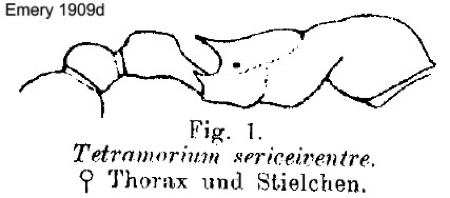 Emery's (1877b)
description is at Emery's (1877b)
description is at  . Arnold (1917: 294) gave
a translation,
with femoratum; this is at . Arnold (1917: 294) gave
a translation,
with femoratum; this is at  . Forel's (1884) description of blochmannii
is at . Forel's (1884) description of blochmannii
is at  . Forel's (1894b) description of debile
is at . Forel's (1894b) description of debile
is at  . Emery's (1895h)
description of femoratum is at . Emery's (1895h)
description of femoratum is at  . Forel's (1907c) description of neuvillei
is at . Forel's (1907c) description of neuvillei
is at  . Forel's (1910e)
description of continentis is at . Forel's (1910e)
description of continentis is at  . Stitz's (1910)
description of nigriventre is at . Stitz's (1910)
description of nigriventre is at  . Arnold's (1917) translation of continentis
is at . Arnold's (1917) translation of continentis
is at  Santschi's (1918b)
description of varieties are at Santschi's (1918b)
description of varieties are at  , ,  , ,  and and  ; in his key cinnamoneum was among those with
dense sculpturation but concolorous and reddish, TL 3.3-3.5 mm. Arnold
(1926) gave
translations of several varieties (including most of the Santschi,
1918b, descriptions), these are at ; in his key cinnamoneum was among those with
dense sculpturation but concolorous and reddish, TL 3.3-3.5 mm. Arnold
(1926) gave
translations of several varieties (including most of the Santschi,
1918b, descriptions), these are at  , ,  and and  .
Santschi's (1926b) description of vividum
is at 17. Santschi's (1928f)
descriptions of evidens and gladiator are at 18.
Santschi's (1933b) description of kenyensis is at 19. Santschi's (1937g) description of the arenarium
male is at 20. .
Santschi's (1926b) description of vividum
is at 17. Santschi's (1928f)
descriptions of evidens and gladiator are at 18.
Santschi's (1933b) description of kenyensis is at 19. Santschi's (1937g) description of the arenarium
male is at 20.
|
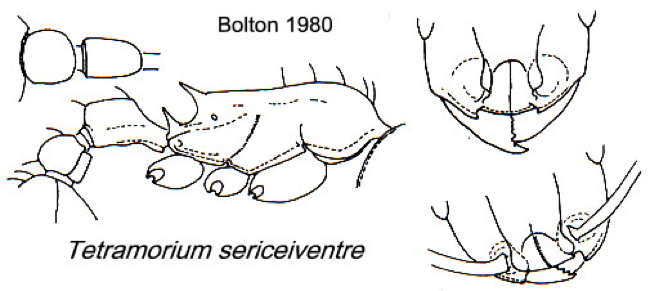 Bolton's modern
description (1980) is at 21
and 22
-
TL 3.3-4.4 mm, in Bolton (1980: 332), illustrated, head, clypeus and
mandibles, alitrunk and pedicel profile, pedicel dorsum. Bolton's modern
description (1980) is at 21
and 22
-
TL 3.3-4.4 mm, in Bolton (1980: 332), illustrated, head, clypeus and
mandibles, alitrunk and pedicel profile, pedicel dorsum.
Santschi (1910c) noted inversa as being larger,
TL 3.5-4 mm, and more robust than the type, with heavier sculpturation
but a less silky appearance to the gaster. Bernard's (1948) description
of "Atopula hortensis" is at  This also contains
ecological and biological observations. This also contains
ecological and biological observations.
|
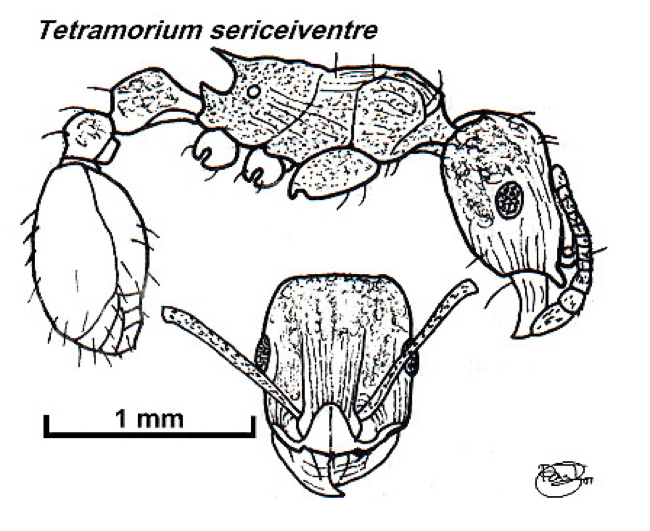 Nigeria
specimens (Taylor, 1980a:
51). WORKER. TL 3.92 mm, HL 0.93, HW 0.78, SL 0.90, PW 0.59 Nigeria
specimens (Taylor, 1980a:
51). WORKER. TL 3.92 mm, HL 0.93, HW 0.78, SL 0.90, PW 0.59
Head, alitrunk and pedicel densely and finely punctate with overlying
rugoreticulation; rugae longitudinal especially on the head and dorsal
alitrunk. Gaster with extremely fine puncturation. Erect hairs stout,
sparse and moderately long. Propodeal spines relatively long, narrow
and triangular, pointing slightly upwards. Petiole node with a sloping
anterior face merging through a rounded obtuse angle into the dorsum
with a slightly convex profile; posterior face near vertical. Colour
orange-brown, except the gaster which is very dark near black.
|
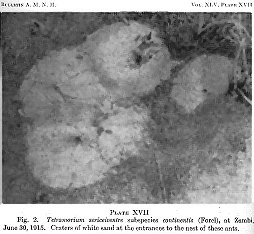 Basically a savannah species but found
nesting in insolated ground in the forest zone. Found foraging below
the soil surface. Bolton (1980) lists numerous West African findings. Basically a savannah species but found
nesting in insolated ground in the forest zone. Found foraging below
the soil surface. Bolton (1980) lists numerous West African findings.
In Nigeria, including the Cocoa Research
Institute of Nigeria, Idi Ayunre (B. Bolton; B. Taylor), IITA (B. R.
Critchley), Ibadan and Nsukka (W.H. Gotwald & R. Schaefer), Mokwa
(C. Longhurst), Ile-Ife and Gusau (J.T. Medler), Bauchi (Walker).
Wheeler (1922) had nigriventre from Ibadan (F. Silvestri), plus
the type form from Old Calabar (Bates, in Forel, 1911) and Ibadan (F.
Silvestri).
In Ghana, Room (1971) found it in leaf litter
under cocoa and on open ground at the Mampong Cemetery site. That was
listed by Bolton (1980), plus many other findings - Asesewa and CRIG
(B. Bolton), Dahwhenya (C. A. Collingwood), Krobo (A.H.
Strickland), Besuso, Larteh and Legon (D. Leston).
Lévieux & Diomande (1978) in their description of
the activity of Pachycondyla sennaarensis at Ferkéssédougou,
Ivory Coast, mentioned that Tetramorium sericeiventre was
an active predator on other ants, and that twice they had seen it
transporting Pachycondyla sennaarensis workers to its nest.
Other West African records are Liberia, at
Harbel (W.M. Mann); Senegal, near Dakar (W.L. Brown); Ivory
Coast, at ORSTOM (W.L. Brown); and Cameroun, at Nkolbisson
(no details). Wheeler (1922) had the type form and nigriventre also
from Guinea (Conakry and Kakoulima, F. Silvestri); plus the
type form from Sierra Leone; and arenarium from Senegal
(at Fello, by Claveau). The nests of continentis in Zaïre
were described as "small nests in sand" some 50 cm deep with
crater-like entrances, the crater rims being entirely of sand
particles, with no food debris; the ants were busy even in a fairly
bright midday sun (see illustration left and "click").
|
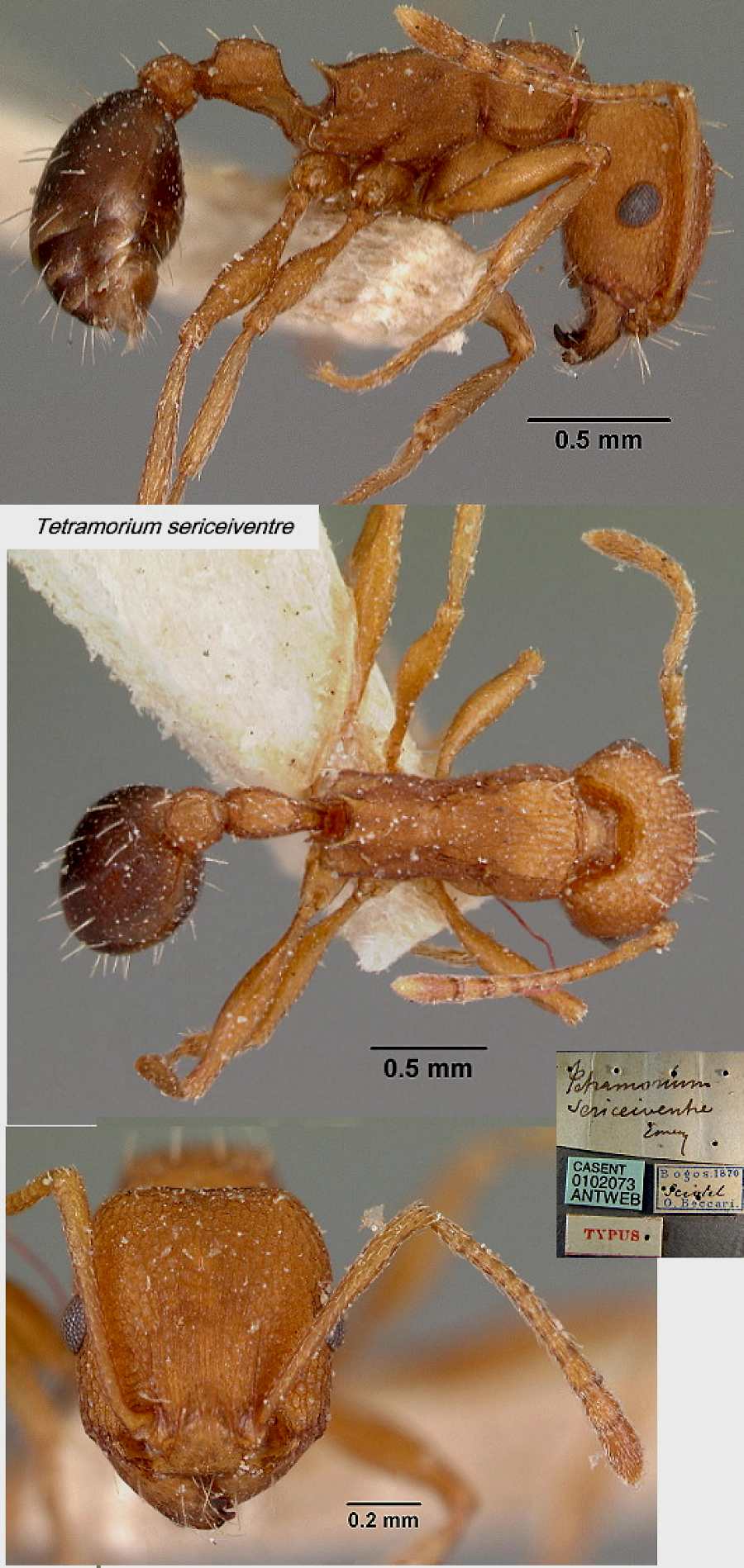 The
photomontage of the holotype from Eritrea is
collated from http://www.antweb.org/specimen.do?name=casent0102073 The
photomontage of the holotype from Eritrea is
collated from http://www.antweb.org/specimen.do?name=casent0102073
See also https://www.antweb.org/specimenImages.do?name=casent0102129
|
Oxford University
Museum
specimens
|
 The
photomontage is of a worker from Gabon,
Pongara National Park, Pointe Ngombé; collector Yves Braet (Gabon 19). The
photomontage is of a worker from Gabon,
Pongara National Park, Pointe Ngombé; collector Yves Braet (Gabon 19).
This is close in general configuration and colour to the type form.
The head width is not much less than the head length. The overall
sculpturation on the head, alitrunk and pedicel is distinct but weak.
The mandibles are only weakly sculptured, appearing almost smooth from
some angles. The gaster is relatively pale and more brown than black.
|
 The photomontage is
of a worker collected in Cameroun
- 30 km east of Poli (ca °29' N 13°29' E) at a Sudan-Guinea savannah
location (McKey Wolbachia project - Cameroon 126). The photomontage is
of a worker collected in Cameroun
- 30 km east of Poli (ca °29' N 13°29' E) at a Sudan-Guinea savannah
location (McKey Wolbachia project - Cameroon 126).
A single specimen in a sample of numerous Monomorium
bicolor - a species with a very similar colouration. This seems
a match for the variety nigriventre, as described from Cameroun
by Stitz (1910), i.e. more brightly coloured and more coarsely
sculptured than the type form.
|
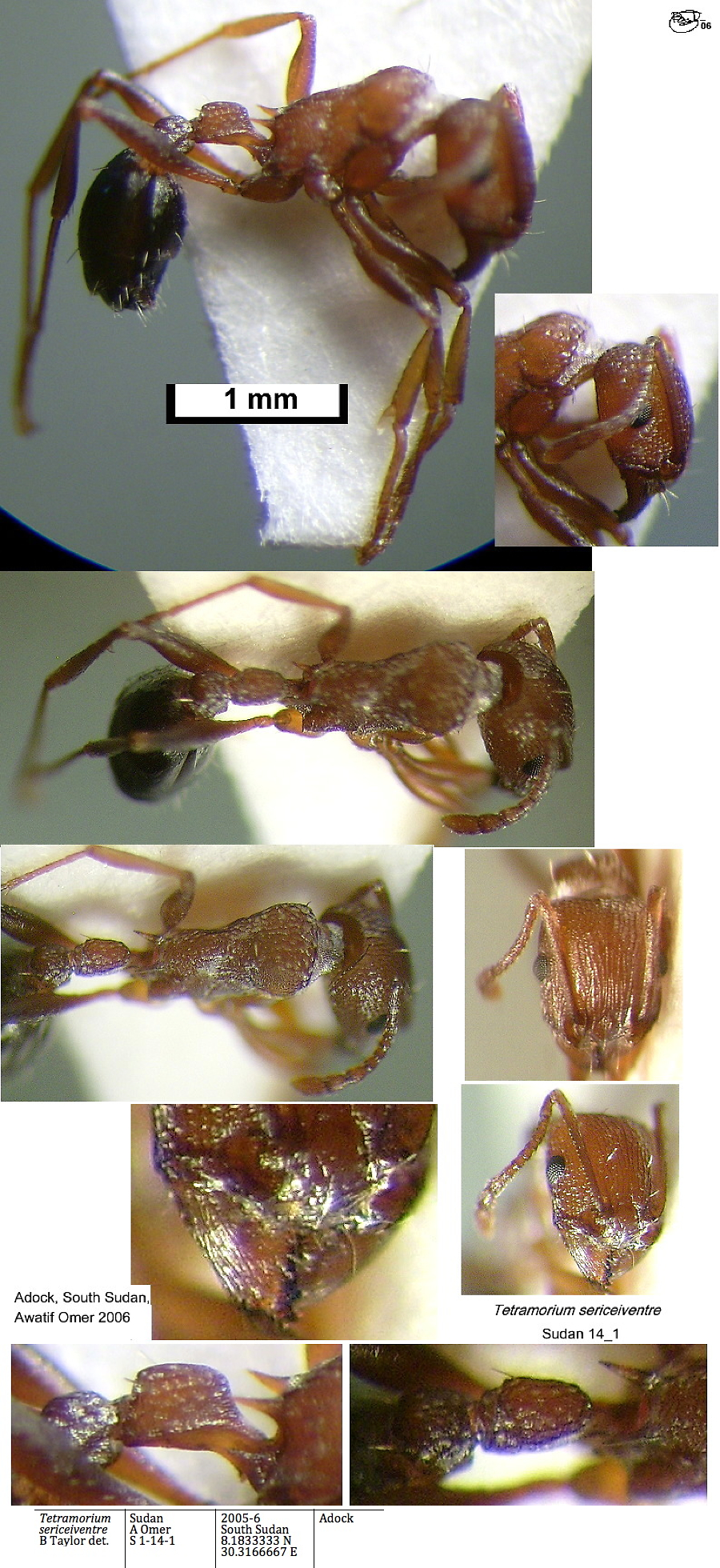 Photomontage of a
worker from South Sudan, Adock; collector Awatif Omer (Sudan
14-1). Photomontage of a
worker from South Sudan, Adock; collector Awatif Omer (Sudan
14-1).
This
seems close to the description given by Santschi (1918b) for n. var hori,
from Khartoum; with the rugulose petiole and dark colour. The
characters also match those given by Bernard (1948) for "Atopula
hortensis", particularly distinct are the sparse stouter erect
hairs and the relatively slender overall shape; with noticeably longer
legs (the hindfemur is as long as the alitrunk dorsum) and longer
propodeal spines. Given more specimens, I suspect that hori
could be argued as a clearly distinct species, junior synonym hortensis;
being a species distributed across the Sahara or Sahel.
|
 Photomontage of a
worker from Ghana, collected
by S Sky Stephens, 2006. Photomontage of a
worker from Ghana, collected
by S Sky Stephens, 2006.
|
 Bernard (1952) described it as a common African insect,
from the Tunisian steppes to Transvaal, with at least 8 races and 30
varieties. In Guinea, several workers collected from Mt. Nimba
- from Kéoulenta savanna, and Mount Tô Ravine I - differed from known
forms by their darker red-brown colour, stronger reticulation (masking
the longitudinal striation) and a head vertex which was more deeply
impressed. He felt that it may have represented a simple summation of
montane development, as a queen taken at Nimba more clearly matched the
type form. Bernard (1952) described it as a common African insect,
from the Tunisian steppes to Transvaal, with at least 8 races and 30
varieties. In Guinea, several workers collected from Mt. Nimba
- from Kéoulenta savanna, and Mount Tô Ravine I - differed from known
forms by their darker red-brown colour, stronger reticulation (masking
the longitudinal striation) and a head vertex which was more deeply
impressed. He felt that it may have represented a simple summation of
montane development, as a queen taken at Nimba more clearly matched the
type form.
|
 The
photomontage here is of a slender form from Gabon,
Pongara National Park; collectors L Volait & L V
Guieu (Gabon 17); that seems a close match to Bernard's (1948)
illustration of hortensis. The
photomontage here is of a slender form from Gabon,
Pongara National Park; collectors L Volait & L V
Guieu (Gabon 17); that seems a close match to Bernard's (1948)
illustration of hortensis.
|
|